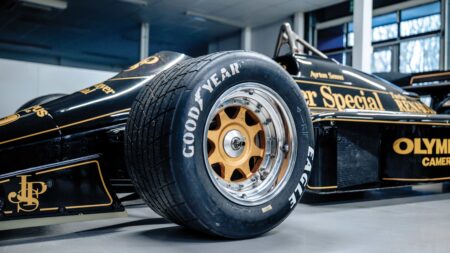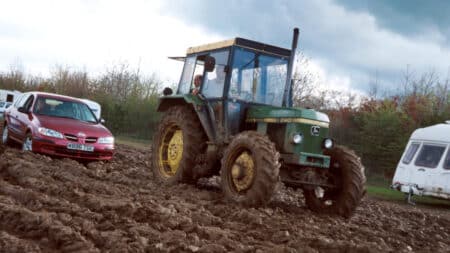
Why Kimi Antonelli was the silver lining in Mercedes' 'worst' F1 race of 2025
As Mercedes dropped down the F1 order in Saudi Arabia, team boss Toto Wolff found a hope in Kimi Antonelli's performance for the team
Twenty years after winning the Italian Grand Prix in a Ferrari, Gerhard Berger was back on the Monza podium on Sunday, but this time as the very proud co-owner of the Toro Rosso team, for at just 21 years and 74 days, Sebastian Vettel had made history by becoming the youngest driver – by almost a year – ever to win a World Championship Grand Prix. While many of greater experience and loftier reputation floundered in the treacherous conditions at Monza, Vettel put in a drive worthy of a Prost or Schumacher, and at no stage of the afternoon looked under the remotest threat.

Afterwards the words tumbled out in a smiling, almost disbelieving, rush: “For sure this is the best day of my life. I kept saying to myself, ‘Still P1 on my board – how can it be?’ The reaction of the crowd on my slowing-down lap, being on podium… it was all even better than I thought it could be. In fact, I had a lot of fun from the first lap to the last. It was just… a very nice race!”

Vettel’s victory could hardly have been better received, for it is always good to see new winners in the sport, and Sebastian is a personable young fellow with a very ‘English’ sense of humour – you don’t find many Germans who can quote great chunks of Fawlty Towers.
In recent weeks the Toro Rosso team has progressed strongly, but still it was a surprise when Vettel took pole position. Yes, his Ferrari engine was in its element at the fastest circuit in Formula 1 use, and yes, as we saw at Spa, the Toro Rossos invariably show well in wet conditions, which was what we had at Monza throughout Friday and Saturday, but still to see the name of Vettel, rather than Hamilton or Massa, at the top of the list was unexpected.
On race day it rained again, but not too many in the paddock believed that Vettel and Toro Rosso would convert pole position into victory – indeed most people’s money was on Heikki Kovalainen, who joined Sebastian on the front row.

In this day and age, it was more or less inevitable, given the conditions, that the race would start behind the safety car, but after two laps like that they were given the signal to go, whereupon Vettel got away perfectly, and that was crucial, for on a day like this only the leader could properly see where he was going. Sebastian certainly made the most of that advantage, and in the early laps his car was as much as 20kph faster than any other on Monza’s long straights. By lap 18, when he made his first stop, he had built up a lead of 12 seconds over Kovalainen.
By now the worst of the rain had passed, but still there was no question of switching from ‘full wet’ tyres to intermediates. Vettel temporarily dropped to fourth place, but as Kovalainen, Webber and Massa came in for their stops, he retook the lead, and thereafter never lost it.
By the time of Vettel’s second stop, on lap 36, conditions had improved to the point that now intermediates were the thing to have, and this worked much to the interests of drivers such as Kubica who started the race with a load of fuel on board, and planned only on a single stop. By the time their stops came around, it was a straightforward decision to put on ‘inters’.
Kovalainen duly finished second to Vettel, and seemed dejected after a race he had clearly expected to win for McLaren: “In today’s cool and wet conditions, I struggled to keep temperature in the brakes – it’s normally a problem that goes away after a few laps, but today it didn’t. I also had problems with the ‘full wet’ tyres in the first two stints, and it was only at the end, when we were both running ‘inters’, that I was able to run at Sebastian’s speed. By then, of course, there was no time left to do anything…

Kubica, Alonso and Heidfeld benefited from their one-stop strategies, switching from wets to intermediates at the ideal time, and consequently finishing ahead of such as Massa and Webber, who were on two-stoppers, and for part of the time at least were on tyres not ideal for the changing conditions.
The World Championship situation changed little at Monza, for the two leading protagonists finished only sixth and seventh, Massa gaining a single point on Hamilton as a consequence. At no stage, indeed, were either in serious contention, thanks to tribulations in qualifying.
Two major surprises had awaited in Monza. First, Ferrari announced that Raikkonen’s contract had been extended by a year, to the end of 2010, and in light of a string of substandard performances in the recent past, not many had seen that coming.

The second surprise, of course, was the weather. No sign this year of the sun and long autumnal shadows traditionally associated with Monza in September: every day the rain came down, and hard, and we became used to lightning cracking across the dark skies.
The conditions were awful for qualifying, and, in light of his remarkable speed in the wet at Spa, Hamilton had been widely regarded as the likely pole man. As it was, though, Kovalainen was McLaren’s pacesetter throughout, and Lewis failed even to get through to Q1, qualifying a lamentable 15th, far and away the worst grid position of his F1 career.
Hamilton may have been only one place behind Raikkonen, but crucially he was nowhere near Massa, who didn’t have the greatest session himself, but still set sixth best time.
Between them, Lewis and his team could not have got it more wrong. At the beginning of Q2 everyone, fearful that another have fall of rain was imminent, dashed out, but McLaren clearly expected conditions to improve, for Hamilton did not immediately go out – and when he did, his car, amazingly, was on intermediates, rather than ‘full wets’. By this time, too, conditions had actually worsened, so that Lewis, in spite of stopping for wets, was always chasing his tail, with every lap a little slower than the one before.
For whatever reason, he never looked at ease throughout his qualifying session, and afterwards said that, in the poor visibility, it was difficult to pick out the braking points. No argument there – but it was the same for everyone, and such as Kovalainen and Bourdais and Rosberg were impressive throughout. No one, though, had any answer to Vettel, who was very swift, very composed, and entirely free of serious error, just as he was to be on race day.

On Sunday Hamilton drove a typically muscular race, taking no prisoners at all as he marched through from 15th to an eventual seventh, and he left Italy still in the lead of the World Championship – but only by a single point.
Monza, though, will be remembered as the scene of a first victory by a team and a driver. Toro Rosso employs a total of 168 people, about the same number some teams appear to have in their marketing departments. Chassis by Adrian Newey, engine by Ferrari: it’s a potent mix, and all handled by a smiling 21-year-old who looks increasingly like the next great driver. At the end of the season he leaves Toro Rosso for Red Bull, the ‘mother team’ (which has still to win a race); one inevitably wonders how long it will be before Luca di Montezemolo and Ron Dennis come calling.

As Mercedes dropped down the F1 order in Saudi Arabia, team boss Toto Wolff found a hope in Kimi Antonelli's performance for the team

Zak Brown is still adamant on his approach that Lando Norris and Oscar Piastri are ‘number ones’ at McLaren. But how long will it be before history repeats itself and takes a sour turn?

It's 40 years since Ayrton Senna's incredible first F1 win at Estoril – we captured the brilliant grand prix car he did it in for this month's magazine

Twenty-five years ago, the British GP was the subject of a 'prank' by the powers that be as Bernie Ecclestone and Max Mosley made the BRDC hold the race on Easter Sunday. But the chaos that ensued didn't have the desired effect, as Matt Bishop recalls